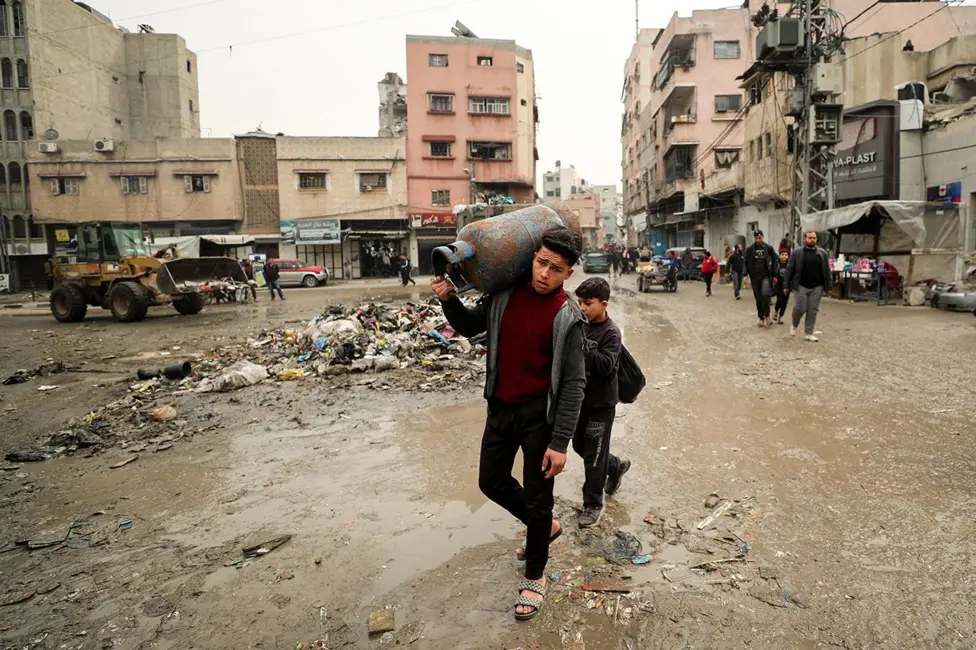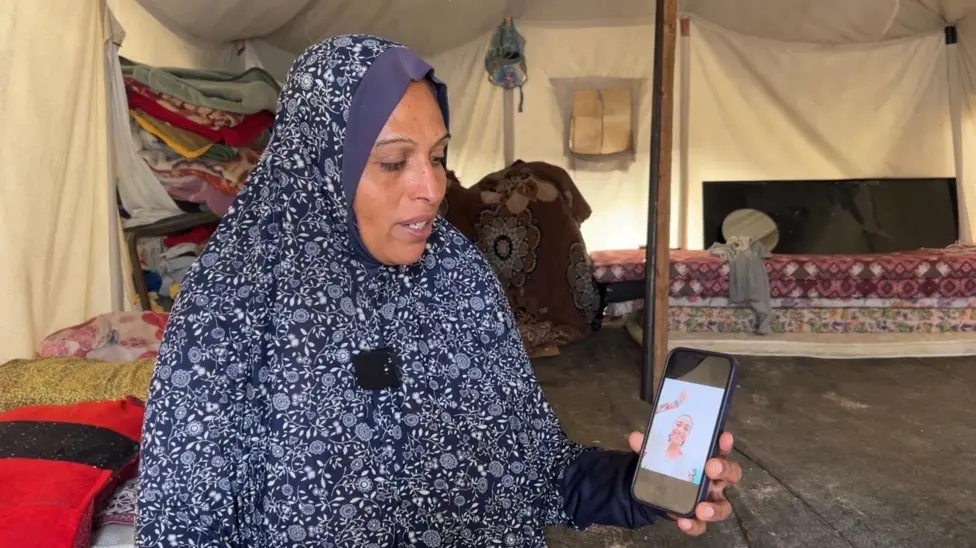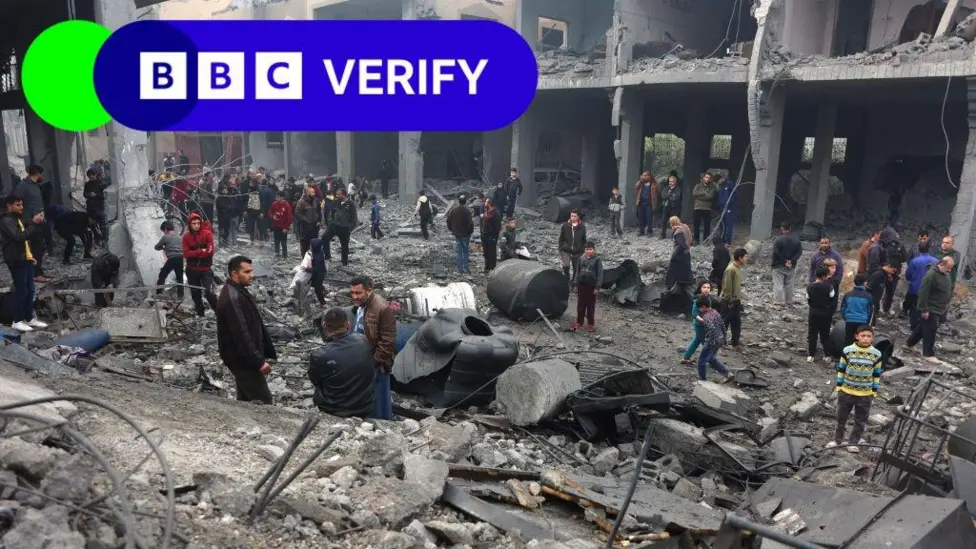Access to power and internet is limited in Esraa Shaheen's neighbourhood in northern Gaza - where Israeli bombing has destroyed much of the infrastructure.
But news of US President Donald Trump's plan to relocate Palestinians from the territory still reached here.
"You feel that you are not in control of your own life... that our lives are cheap," she says, calling his comments provocative.
But looking around, she can't help but agree with him about the "death and destruction" that is everywhere in the territory.
Image source, Ali Jadallah/Anadolu

The 23-year-old says the neighbourhood she grew up in is now almost unrecognisable.
Despite that, she is determined to stay, describing to the BBC through a series of phone calls, videos and messages her long journey home and her joy at being reunited with her fiance - a joy that she says outweighs the difficult situation she now faces in the north.


The journey begins
A natural introvert, Esraa struggled with living for months in a crowded classroom in central Gaza.
"I prefer to stay at home, specifically in my own room, than to go out and walk around or anything like that. I prefer quiet," she says.
In the classroom, "there was no place for calm, stability, or comfort".
So when news broke of the fragile ceasefire between Israel and Hamas, Esraa delighted at the idea of returning to the neighbourhood where she was born and raised, despite what she had heard about the destruction there.
It followed 15 months of war that began the day after her graduation, when Hamas fighters killed some 1,200 people in Israel and took 251 others hostage. More than 47,500 people in Gaza were killed in the Israeli offensive that followed, according to the Hamas-run health ministry. About two thirds of Gaza's buildings were destroyed or damaged, the UN estimates.

Her fiance had remained in the north of Gaza where he worked at a hospital. At first he had chosen not to leave, and then he had been unable to get out, she says.
Within days of the start of the war, over a million people were ordered to leave northern Gaza by the Israeli military as it fought Hamas gunmen, with more forced evacuations in the months that followed. The Israeli military then established a corridor spanning the width of Gaza, blocking people from travelling back north.
But the ceasefire deal included an agreement for displaced people to return north, and so Esraa packed her bags days before the crossing opened and waited for permission to move.
On the morning of 27 January, she picked up her phone and recorded a video.
"The joy is overwhelming," she says, looking down the camera, before setting off.



Road to reunion
The Gaza Strip is a small enclave, and Esraa's journey home was only about 20km from Deir al-Balah. But the crowds of people and difficult terrain meant it would be arduous and take seven hours - first by car, then on foot, and then by car again.
She first drove as close as she could get to the coastal al-Rashid street, where a sea of people headed north - the one place people could cross on foot.
Image source, Ashraf Amra/Anadolu

Hundreds of thousands of displaced Palestinians were making the journey back to their communities in northern Gaza after more than a year of displacement.
Small children were carried along with any possessions people were able to bring with them. Prams were filled with supplies and pushed over mounds of dirt.
"Until the middle of the journey, people were happy and singing and stuff like that, but then when it was taking a long time, people were getting frustrated," Esraa later said.
"It was so long and tiring."
In a video filmed during the journey, Esraa says that if the scenery in central Gaza is like this she "cannot imagine what we will see in the north and what kind of destruction there will be".
The crowd eventually reached a sign saying "Gaza welcomes you", signalling that they had arrived in Gaza City.
"Finally. Thank God. Thank God," she says in the recording of her journey. "The destruction is indescribable. Mixed feelings, but joy prevails."
Esraa’s fiance Mohammad was waiting with a bunch of flowers as she returned. She cried as she fell into his arms, before he drove her back to their neighbourhood listening to a song about lovers being reunited.

"This feeling - we needed it," she recalls of the reunion.
As they drove home, she saw that much of her neighbourhood was in ruins.
"I remember all its details - its streets and houses," she later said over the phone. Now "I could not recognise the places, nor the houses nor the streets. I could not recognise any of them. The neighbourhood is like a pile of stones."
Image source, June 2023, Planet Labs
Satellite image of al-Saftawi neighbourhood in 2023, image
Esraa grew up in a neighbourhood in Gaza City on al-Saftawi Street. Before the 7 October attacks in 2023, it was a built-up area with shops, schools and flats.
Image source, February 2025, Planet Labs
Satellite image of al-Saftawi neighbourhood in 2025, image
But after 15 months of war, like many other parts of the city, there is evidence of the conflict all around. People are living in damaged or bombed-out buildings, others are taking shelter in tents.
Image source, June 2023, Planet Labs
Satellite image of al-Saftawi neighbourhood in 2023, image
Esraa grew up in a neighbourhood in Gaza City on al-Saftawi Street. Before the 7 October attacks in 2023, it was a built-up area with shops, schools and flats.
Image source, February 2025, Planet Labs
Satellite image of al-Saftawi neighbourhood in 2025, image
But after 15 months of war, like many other parts of the city, there is evidence of the conflict all around. People are living in damaged or bombed-out buildings, others are taking shelter in tents.


Back home
Esraa’s first-floor three-bedroom family apartment is still intact, though the windows and doors have been blown off. Other floors in the building are destroyed.
The neighbourhood was an early target of Israel’s military campaign, which it says aimed to destroy Hamas. One large building located nearby was flattened within weeks of the war starting, and more destroyed structures and craters are visible in satellite images of the area from the first months of the war.
In a storm this week, plastic sheets put over the open spaces in Esraa’s apartment blew down. She and her relatives covered themselves with blankets to try to keep warm.

The home was looted while the family were away, and Esraa says there is no longer any furniture there. Her beloved camera, its three lenses and her laptop are also gone.
"I left them in the north thinking I’d come back and pick them up," she says.
The family light fires to try to ward off insects that now crawl through the apartment. They carried gas canisters from the south so that they could continue to cook.
Getting to the market to buy food is difficult because many roads are now inaccessible, she says.

The busy streets around the apartment used to be permanently lit up, while now they are in darkness. She remembers the noise of deliveries to a nearby supermarket that has been destroyed in the war.
Some, upon seeing the destruction, have headed back to tents or buildings for displaced people in the south, deeming the north uninhabitable.
The UN Environment Programme has warned that it could take 21 years to remove and dispose of all the debris left by Israeli bombardments.
There are concerns about sanitation, and access to basic services and supplies, particularly in the north of the strip.
Esraa agrees that life was easier in the south. Sometimes she misses the crowded classroom where "at least there were windows".
But she says doesn't have "any thoughts about going back".
"There is no water, no electricity, no internet but this joy [of returning home] was bigger than all of this," she says.
"We will stay and we will rebuild our home."



 What we know about the Gaza ceasefire deal
What we know about the Gaza ceasefire deal
 My daughter's bones were scattered on the ground'
My daughter's bones were scattered on the ground'
 How 15 months of war has devastated Gaza
How 15 months of war has devastated Gaza